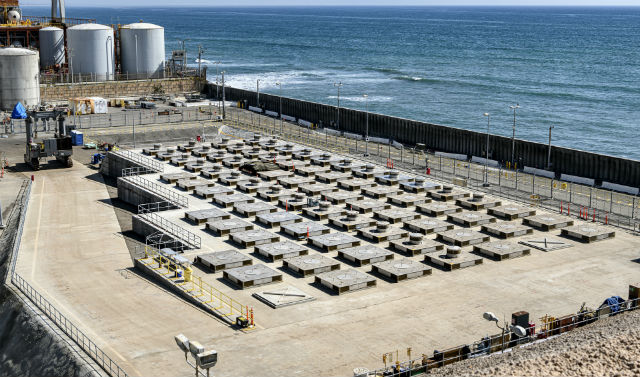 Dry canister storage of nuclear waste at the San Onofre Nuclear Generating Station. (File photo courtesy of Southern California Edison)
Dry canister storage of nuclear waste at the San Onofre Nuclear Generating Station. (File photo courtesy of Southern California Edison)
Sept. 30, 2025, may mark the day communities in Southern California first took initiative to protect themselves from deadly nuclear waste stranded indefinitely at the decommissioned San Onofre nuclear plant.
With Irvine Mayor Larry Agran spearheading the effort, a special study session of the Irvine City Council convened to address the risks of 3.6 million pounds of highly radioactive spent nuclear fuel stored in temporary canisters, out in the open, in an earthquake zone, and just 108 feet from the shoreline. The safety threats include terrorism, sea level rise, earthquakes, tsunamis, and cannister corrosion from exposure to moist, salty air.
Because many of the fission products of nuclear reactors, like Cesium-137, are highly radioactive and extremely long-lived, spent fuel requires isolation for hundreds of thousands of years. Each of San Onofre’s 123 canisters contains about one-third the Cesium-137 as was released during the 2011 Fukushima nuclear disaster.
The canisters were not designed for long-term storage and lack methodology to monitor in real time for radiation leaks or canister degradation.
The nuclear waste will remain at San Onofre for the foreseeable future because of the federal government’s failure to create a permanent geologic repository for the nation’s commercial spent fuel, as mandated by law. In response, some lawmakers are hoping to convince communities in Texas and New Mexico to amass the waste in “consolidated interim storage” facilities until a geologic repository materializes. So far, such efforts have been blocked by those states out of fear of becoming de facto permanent waste dumps.
For us living near San Onofre, it is critical to understand that, even if a community somewhere consented to hosting interim storage, the earliest one could open would be 2038-2040, according to the Department of Energy. Then, it could take a few more decades for all of San Onofre’s spent fuel to be relocated because of competition with other nuclear plants to transfer their waste too.
This means we should be planning for this nuclear waste to remain at San Onofre until at least 2060.
Agran’s opening remarks emphasized the responsibility of every level of government – including local jurisdictions — to protect its citizens. He is calling on Irvine to commission the development of a plan to move San Onfre’s spent fuel into a safer storage configuration until the federal government can take possession of it.
Agran’s proposal includes relocating the canisters away from the shore, onto higher ground at Camp Pendleton, and into a storage building both fortified to eliminate exposure to the marine environment and disasters like earthquakes, tsunamis and terrorism, and equipped to repackage the waste if the canisters fail.
There is urgency to relocate the waste now while the canisters retain enough structural integrity to be moved. Components of the proposal have been informally endorsed by several nuclear safety experts with whom I have consulted privately in working alongside Agran.
A prior chairman of the Nuclear Regulatory Commission, Dr. Gregory Jaczko, topped the study session’s speakers list. His concerns included the renewal of official permits allowing San Onofre’s spent fuel to remain stored as is. He supports efforts on the local level to “move forward” to a better interim storage solution.
A presentation followed from Dr. David Richardson, a UC Irvine professor of environmental and occupational health. Though he primarily researches cancer risks from radiation exposure, he explained how a radiation release also greatly alters people’s relationship to the environment, affecting property values, use of gardens, and deciding where to live. He has consented to assist in developing a plan for San Onofre.
Dan Stetson, chairman of the community engagement panel for the decommissioning of the San Onofre plant, described the panel’s purpose as providing a venue for the public to engage in what are often “spirited” discussions with Southern California Edison. He stressed that the company and the public are both focused on the safe storage of the fuel and its prompt removal. The panel’s solution, however, is finding communities to host interim storage..
The final presenters were representatives of Southern California Edison: Frederic Bailly, the chief nuclear officer, and Manuel Camargo, the principal manager of decommissioning. Bailly explained Edison’s view that “the spent fuel storage is safe where it is” and that “there is no credible scenario that could result in the release of radiological material beyond the site.” Camargo, however, stressed the company’s energetic support of “getting the spent fuel offsite” and explained that amendments to existing law would be necessary to make way for interim storage.
About 150 members of the public filled the council chambers. The 17 commentors from the public were unanimous in voicing concerns about leaving the spent fuel as is.
The session closed with poignant testimony from Councilmember Mike Carroll, who recounted his personal experience in exposing biohazardous government research in New York which resulted in the shutdown of a laboratory. He enumerated many shortcomings he sees in how San Onofre’s spent fuel is currently stored.
A council vote on Agran’s proposal will take place soon. His hope is that, with Irvine taking the lead, other jurisdictions in Orange and San Diego Counties will join in to keep everyone in Southern California safe.
Sarah Mosko is a trained neuroscientist and psychologist who enjoys researching and writing about environmental problems and solutions. She resides in Laguna Beach.
READ NEXT

